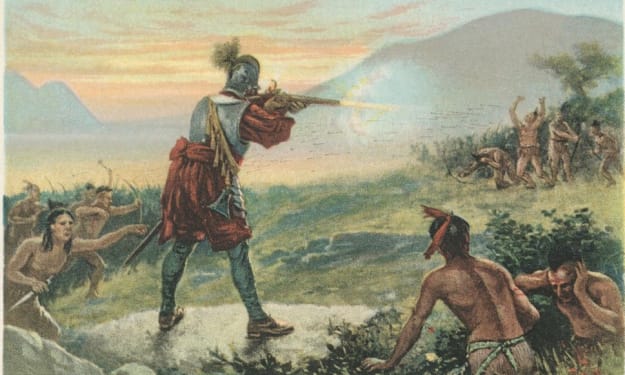The Great Leap Forward:(Part 3)
How the Introduction of French and Dutch Metal Products Transformed the American Northeast

This is the third part in an experimental history series. You can read PART 1, PART 2 here. Rather than publishing my history paper as one large piece, I am breaking it up into a few smaller parts. I would love some feed back on my social media of which is better. Thank you, and enjoy.
____________________________________________________
While the Huron tactical ineptitude was not absolute, it did cause more problems the longer they diverged from their former status as a regional power. This can be seen through the eyes of the French explorer Pierre-Esprit Radisson, who joined the Huron in the early years of his fur trading venture. Radisson arrived in New France in May of 1651. In the short time before his capture he founded the Hudson Bay Company with his brother in-law, Médard Chouart des Groseilliers. In this capacity, Radisson acted as diplomat, merchant, and military advisor to his Huron allies.
Pierre-Esprit Radisson’s account of his time in New France also demonstrates a marked shift in the availability of European metallic wares in the Atlantic northeast. For it was a mere five decades prior that these goods were a scarcity amongst the tribes. But by time Radisson arrives, they are abundant enough to be discarded in an emergency. As this passage from his diaries demonstrates, for they “…made an escape, leaving all their baggage behind, which was not much. Neither had enough to fill our bellies with the meat that was left. There were kettles, broken guns, and rusty hatchets.” (14) The rapid transformation of a society from a Bronze Age level of metallurgy into the modern era by skipping over the Iron Age owed as much to the Europeans introducing high quality goods, as the tribe’s ability to adapt to the new technology. But it was not the mere introduction of a new technology to the Iroquois that allowed them to dominate. For it was their ability to incorporate the tactics needed to make the technology effective that led to their rise above all others.
Radisson gives multiple accounts of how the Iroquois were better able to utilize the technology gained from their Dutch allies against the Huron and their French cohorts. As he recounts, “The Iroquois came with bucklers to make a breach. The French put fire to a barrel of powder, thinking to shake the Iroquois or make them go back…” (15) In this passage Radisson shows how the Iroquois, faced with the same danger as other tribes, were unwilling to give up and press on through a difficult assault. This also shows that they were incorporating more than just muskets, they adopted the tactics needed to effectively employ the European equipment. Bucklers were a rather small type of shield, little larger than a plate. It is important to note that the Iroquois integrated them into a type of siege warfare to gain the advantage in breaching the Huron-French fortification. It shows that they were able to evolve their old shield tactics with the better-quality equipage. In another section of his journal, Radisson demonstrates how the combination of the Iroquois’ fighting spirit and arming them with muskets made them more formidable. In this passage,
"They killed one of our men as we landed. Their number was not [enough] to resist ours. They retired themselves into the fort and brought [in] the rest of their [equipage] in hopes to save it… The Iroquois spared not their powder, but made more noise than hurt… In the meantime, the Iroquois did sing, expecting death…"(16)
Radisson’s writing gives an idea of the Iroquois’s psychology in the face of insurmountable odds. They are organized, well led, disciplined, and in high spirits. Despite a few instances, the Iroquois seem to only break ranks or leave their gear when absolute chaos descends upon them. This is in sharp contrast with the Huron, who often appear to only be organized and well-disciplined when led by their French compatriots. Throughout the first-hand accounts of Radisson and de Champlain, the Huron appear strong and dominant when fighting a weaker tribe, but when faced with an enemy of equal skill, they often fall apart. Their lack of cohesion and discipline belies their more extensive experience with European weaponry. This is reinforced by the work of historians such as Keith F. Otterbein.(17, 18, 19, 20) Through this we come to understand how two societies can be introduced to the same technology but have very divergent results in its application.
In conclusion, the effect of French and Dutch metallurgic technology on the tribes of the Atlantic northeast were profound. The arrival of the Europeans brought with them a level of technology the Huron and Iroquois were wholly unprepared for. While more technologically advanced than many tribes in the North America at the time, no tribe could have been prepared to leap forward the equivalent of several centuries in a short span of time. The fact that two tribes in the same region were able to adopt and utilize the technology as swiftly as they had, demonstrates their propensity for change. Unfortunately, the Huron and Iroquois’s adaptation would not be enough to stave off their inevitable conquest. The Huron were first conquered by the Iroquois, with their eventual absorption into the larger tribe through the Mourning War tradition. But this would not save the Iroquois over the following decades, as they were over taken by Europeans due to their inability maintain their population through near constant war, and the disease that ran rampant throughout all of the native America after contact.
Thank you for reading my work. If you enjoyed this story, there’s more below. Please hit the like and subscribe button, you can follow me on Twitter @AtomicHistorian, and if you want to help me create more content, please consider leaving a tip or a pledged subscriber.
More from this author:
Citations:
13. Keith F. Otterbein, Huron vs Iroquois: A Case Study in Inter-Tribal Warfare, Ethnohistory Volume 26, Number 2 (Spring 1979), 143.
14. Pierre-Esprit Radisson, ed. Arthur T. Adams, The Explorations of Pierre-Esprit Radisson (Minneapolis: Minnesota. 1961), 104.
15. Pierre-Esprit Radisson, ed. Arthur T. Adams, The Explorations of Pierre-Esprit Radisson (Minneapolis: Minnesota. 1961), 106.
16. Ibid., 117.
17. Keith F. Otterbein, Huron vs Iroquois: A Case Study in Inter-Tribal Warfare, Ethnohistory Volume 26, Number 2 (Spring 1979), 143.
18. Ibid., 144
19. bid., 145
20. Ibid., 150






Comments (1)
Interesting & well written throughout. I'm not sure which format is better, breaking the article into parts or leaving it intact. The shorter parts do help with attention spans having grown accustomed to shorter stories, articles & poetry as are common on Vocal &, thus, allows for a greater sense of accomplishment having completed more reads. By the same token, it means continuing to click through a series rather than having the entire thing available in one place. Either way, you provide us with great, informative & eye-opening content.